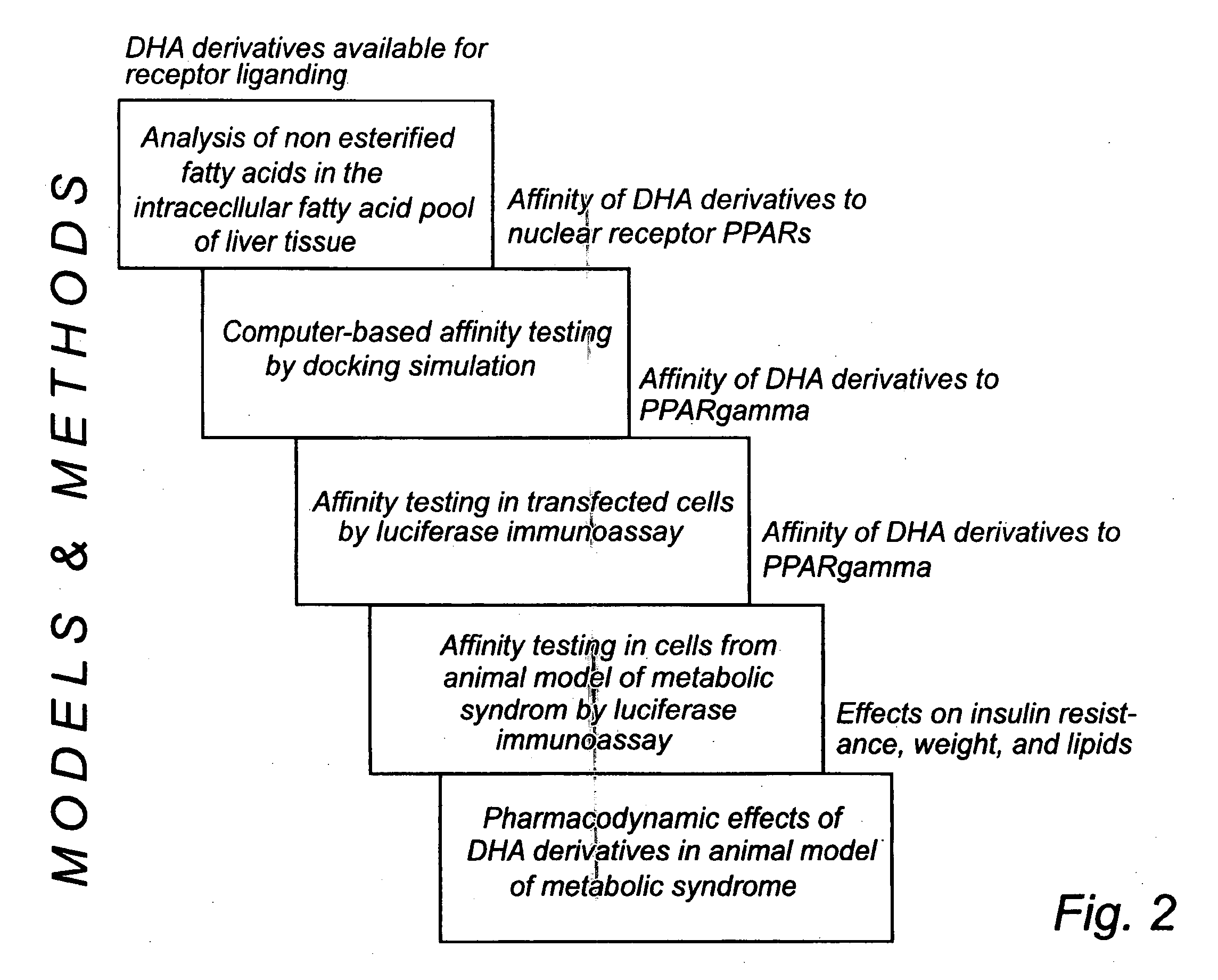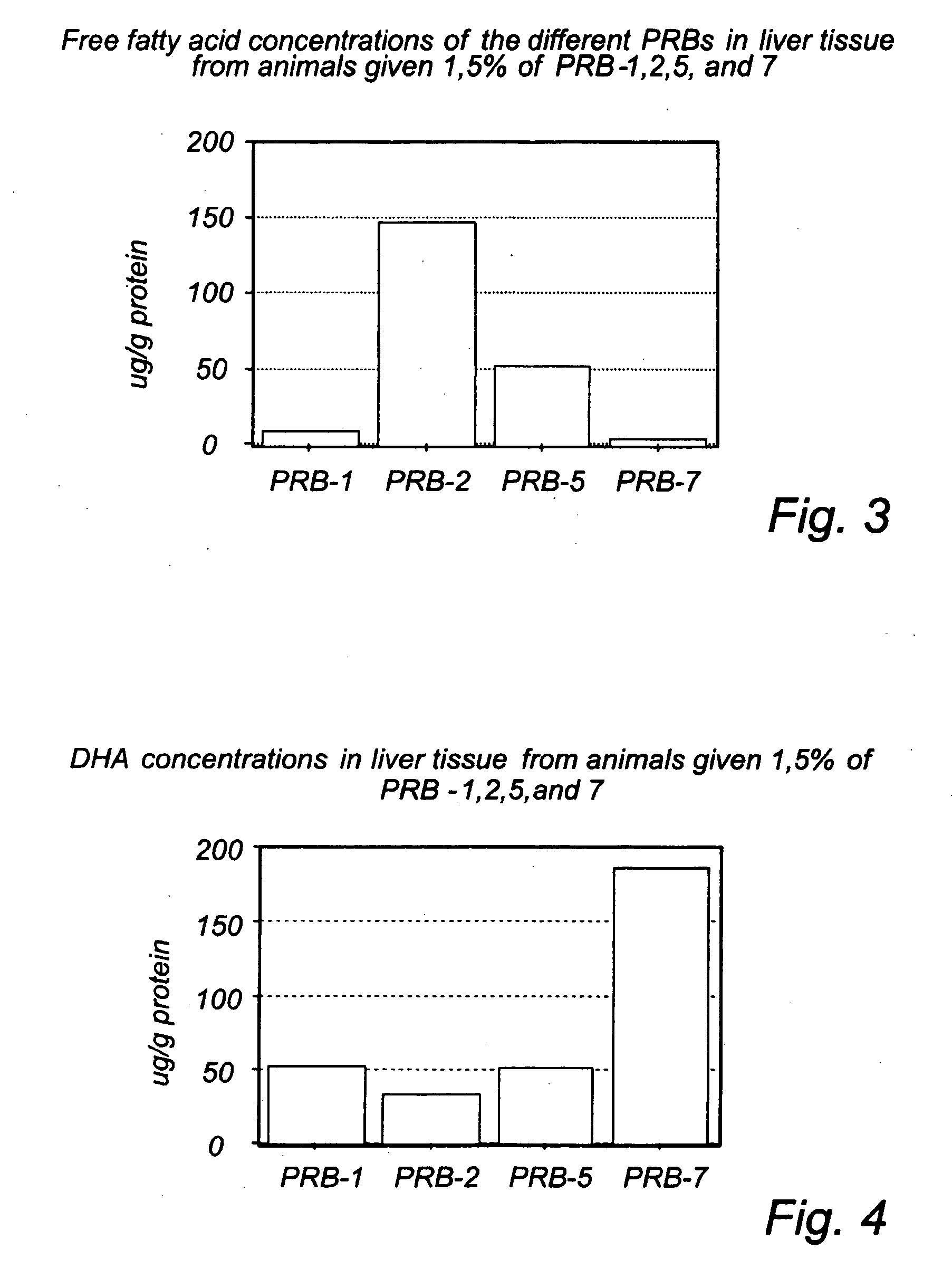Novel compounds
- Summary
- Abstract
- Description
- Claims
- Application Information
AI Technical Summary
Benefits of technology
Problems solved by technology
Method used
Image
Examples
example 1
Analysis of Intracellular Free Fatty Acids (Non-Esterified Fatty Acids) in Liver Cells (Block 1 in FIG. 2)
Background
[0307] In the first block of experiments (see FIG. 2) liver tissue from animals fed PRB-1,2,5, and 7 was analysed with respect to free unesterified fatty acids. The animals were recruited from the fifth block of experiments (pharmacodynamic effects of DHA derivatives in an animal model of metabolic syndrome). The animals had been given DHA (15% of fat content of the diet) or the DHA-derivatives (1.5% of the fat content in their diet) for 8 weeks and were supposed to be in a steady-state situation with stable levels of DHA and the DHA-derivatives intracellularily. Liver tissue was chosen due to the fact that the metabolisation rate is very high in liver.
Method
[0308] The liver samples were homogenized in cold PBS buffer, and extracted immediately with chloroform:methanol (2:1) containing 0.2 mM butylated hydroxytoluene (BHT) using cis-10-heptadecenoic acid as inter...
example 2
Computer Based Affinity Testing (Block 2 in FIG. 2)
Background
[0314] Nuclear receptors have been sequenced and the amino acid sequence is known for the PPARs and other relevant receptors engaged in the genetic control of glucose and fat. X-ray crystallography and NMR spectroscopy of the PPAR receptors are available and computerised affinity testing of fatty acids liganding to the receptors can be used to estimate binding kinetics. The binding geometries, often called binding modes or poses, include both positioning of the ligand relative to the receptor and the conformational state of the ligand and the receptor. Effective ligand docking can therefore be analysed.
[0315] Affinity of the ligand to the receptor is defined by two different parameters: docking of the ligand (DHA derivative) into the binding site of the receptor and electrostatic bonding between certain amino acids of the receptor and the carboxyl group or side chains in the head of the fatty acid. (Krumrine).
[0316] A...
example 3
Affinity Testing in Transfected Cells (Block 3 in FIG. 2)
Background
[0326] Release of luciferase is correlated to transcription of genes. Binding of a ligand to a nuclear receptor such as PPARγ induces transcription of the respective gene thereby releasing luciferase. This technique therefore provides a measure of ligand affinity to the receptor as well as activation of the responsible gene.
Method
[0327] Transient transfection of COS-1 cells was performed in 6-well plates as described by Graham and van der Eb (Graham). For full length PPAR transfection studies, each well received 5 μg reporter construct, 2.5 μg pSV-β-galactosidase as an internal control, 0.4 μg pSG5-PPARγ2. The cells were harvested after 72 h, and the luciferase activity was measured according to the protocol (Promega). The luciferase activity was normalised against β-galactosidase activity. The adipocytes were transfected at D11 of differentiation using 16 μl LipofectaminPlus reagent, 4 μl Lipofectamine (Life T...
PUM
| Property | Measurement | Unit |
|---|---|---|
| Molar density | aaaaa | aaaaa |
| Fraction | aaaaa | aaaaa |
| Fraction | aaaaa | aaaaa |
Abstract
Description
Claims
Application Information
 Login to View More
Login to View More - R&D
- Intellectual Property
- Life Sciences
- Materials
- Tech Scout
- Unparalleled Data Quality
- Higher Quality Content
- 60% Fewer Hallucinations
Browse by: Latest US Patents, China's latest patents, Technical Efficacy Thesaurus, Application Domain, Technology Topic, Popular Technical Reports.
© 2025 PatSnap. All rights reserved.Legal|Privacy policy|Modern Slavery Act Transparency Statement|Sitemap|About US| Contact US: help@patsnap.com



